Ford's Strategic Marketing: Case Study Analysis & Strategies
VerifiedAdded on 2023/04/19
|6
|1907
|316
Case Study
AI Summary
This case study examines Ford Motor Company's strategic marketing challenges and opportunities between the 1960s and 1990s. It begins with a situation analysis, highlighting external factors like economic changes, oil shocks, and increased competition from Japanese automakers, which led to decreased sales and profitability. The study identifies the problem as a high Cost of Customer Acquisition (COCA) due to an expensive warranty policy that wasn't aligned with potential sales margins, reducing the Consumer Lifetime Value (CLV). Alternative strategies such as product diversification, premium pricing, and participation in special events (CSR) are explored. The recommendation focuses on implementing a premium pricing strategy to increase customer loyalty and reduce turnover, requiring a new customer verification process and agreements with local car dealers. The conclusion emphasizes that while Ford initially experienced great success, internal and external turbulences led to losses, and a shift towards premium pricing could improve profitability and customer retention.
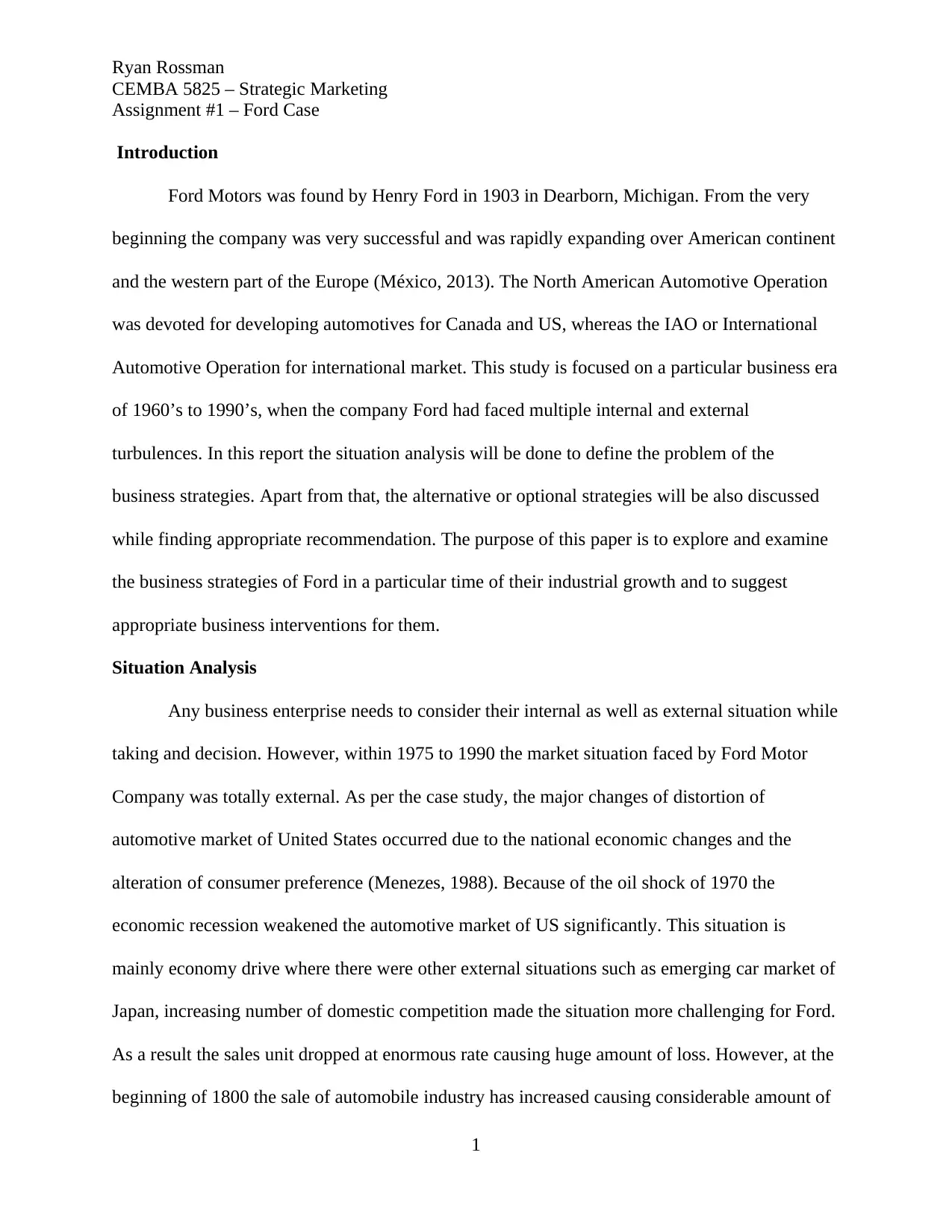
Ryan Rossman
CEMBA 5825 – Strategic Marketing
Assignment #1 – Ford Case
Introduction
Ford Motors was found by Henry Ford in 1903 in Dearborn, Michigan. From the very
beginning the company was very successful and was rapidly expanding over American continent
and the western part of the Europe (México, 2013). The North American Automotive Operation
was devoted for developing automotives for Canada and US, whereas the IAO or International
Automotive Operation for international market. This study is focused on a particular business era
of 1960’s to 1990’s, when the company Ford had faced multiple internal and external
turbulences. In this report the situation analysis will be done to define the problem of the
business strategies. Apart from that, the alternative or optional strategies will be also discussed
while finding appropriate recommendation. The purpose of this paper is to explore and examine
the business strategies of Ford in a particular time of their industrial growth and to suggest
appropriate business interventions for them.
Situation Analysis
Any business enterprise needs to consider their internal as well as external situation while
taking and decision. However, within 1975 to 1990 the market situation faced by Ford Motor
Company was totally external. As per the case study, the major changes of distortion of
automotive market of United States occurred due to the national economic changes and the
alteration of consumer preference (Menezes, 1988). Because of the oil shock of 1970 the
economic recession weakened the automotive market of US significantly. This situation is
mainly economy drive where there were other external situations such as emerging car market of
Japan, increasing number of domestic competition made the situation more challenging for Ford.
As a result the sales unit dropped at enormous rate causing huge amount of loss. However, at the
beginning of 1800 the sale of automobile industry has increased causing considerable amount of
1
CEMBA 5825 – Strategic Marketing
Assignment #1 – Ford Case
Introduction
Ford Motors was found by Henry Ford in 1903 in Dearborn, Michigan. From the very
beginning the company was very successful and was rapidly expanding over American continent
and the western part of the Europe (México, 2013). The North American Automotive Operation
was devoted for developing automotives for Canada and US, whereas the IAO or International
Automotive Operation for international market. This study is focused on a particular business era
of 1960’s to 1990’s, when the company Ford had faced multiple internal and external
turbulences. In this report the situation analysis will be done to define the problem of the
business strategies. Apart from that, the alternative or optional strategies will be also discussed
while finding appropriate recommendation. The purpose of this paper is to explore and examine
the business strategies of Ford in a particular time of their industrial growth and to suggest
appropriate business interventions for them.
Situation Analysis
Any business enterprise needs to consider their internal as well as external situation while
taking and decision. However, within 1975 to 1990 the market situation faced by Ford Motor
Company was totally external. As per the case study, the major changes of distortion of
automotive market of United States occurred due to the national economic changes and the
alteration of consumer preference (Menezes, 1988). Because of the oil shock of 1970 the
economic recession weakened the automotive market of US significantly. This situation is
mainly economy drive where there were other external situations such as emerging car market of
Japan, increasing number of domestic competition made the situation more challenging for Ford.
As a result the sales unit dropped at enormous rate causing huge amount of loss. However, at the
beginning of 1800 the sale of automobile industry has increased causing considerable amount of
1
Paraphrase This Document
Need a fresh take? Get an instant paraphrase of this document with our AI Paraphraser
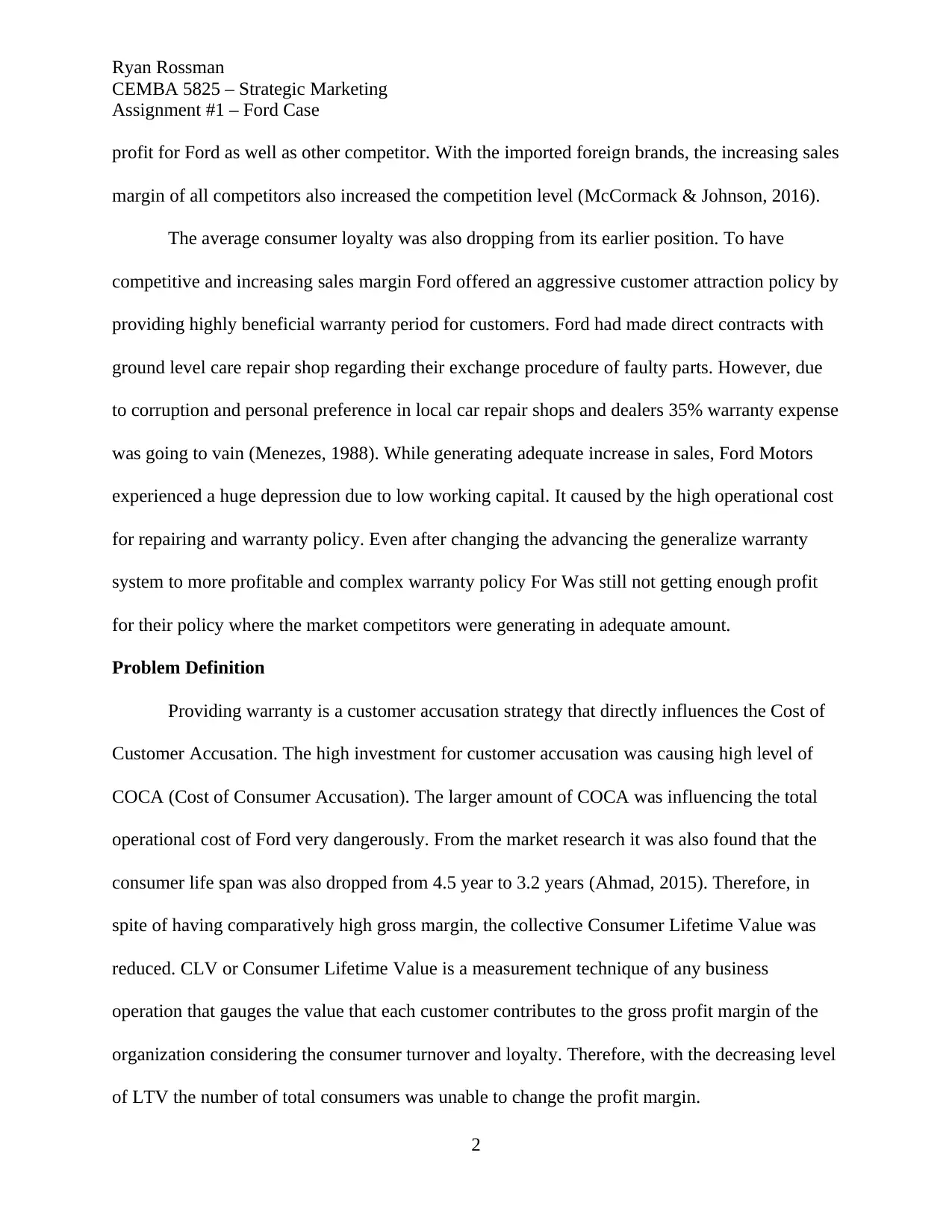
Ryan Rossman
CEMBA 5825 – Strategic Marketing
Assignment #1 – Ford Case
profit for Ford as well as other competitor. With the imported foreign brands, the increasing sales
margin of all competitors also increased the competition level (McCormack & Johnson, 2016).
The average consumer loyalty was also dropping from its earlier position. To have
competitive and increasing sales margin Ford offered an aggressive customer attraction policy by
providing highly beneficial warranty period for customers. Ford had made direct contracts with
ground level care repair shop regarding their exchange procedure of faulty parts. However, due
to corruption and personal preference in local car repair shops and dealers 35% warranty expense
was going to vain (Menezes, 1988). While generating adequate increase in sales, Ford Motors
experienced a huge depression due to low working capital. It caused by the high operational cost
for repairing and warranty policy. Even after changing the advancing the generalize warranty
system to more profitable and complex warranty policy For Was still not getting enough profit
for their policy where the market competitors were generating in adequate amount.
Problem Definition
Providing warranty is a customer accusation strategy that directly influences the Cost of
Customer Accusation. The high investment for customer accusation was causing high level of
COCA (Cost of Consumer Accusation). The larger amount of COCA was influencing the total
operational cost of Ford very dangerously. From the market research it was also found that the
consumer life span was also dropped from 4.5 year to 3.2 years (Ahmad, 2015). Therefore, in
spite of having comparatively high gross margin, the collective Consumer Lifetime Value was
reduced. CLV or Consumer Lifetime Value is a measurement technique of any business
operation that gauges the value that each customer contributes to the gross profit margin of the
organization considering the consumer turnover and loyalty. Therefore, with the decreasing level
of LTV the number of total consumers was unable to change the profit margin.
2
CEMBA 5825 – Strategic Marketing
Assignment #1 – Ford Case
profit for Ford as well as other competitor. With the imported foreign brands, the increasing sales
margin of all competitors also increased the competition level (McCormack & Johnson, 2016).
The average consumer loyalty was also dropping from its earlier position. To have
competitive and increasing sales margin Ford offered an aggressive customer attraction policy by
providing highly beneficial warranty period for customers. Ford had made direct contracts with
ground level care repair shop regarding their exchange procedure of faulty parts. However, due
to corruption and personal preference in local car repair shops and dealers 35% warranty expense
was going to vain (Menezes, 1988). While generating adequate increase in sales, Ford Motors
experienced a huge depression due to low working capital. It caused by the high operational cost
for repairing and warranty policy. Even after changing the advancing the generalize warranty
system to more profitable and complex warranty policy For Was still not getting enough profit
for their policy where the market competitors were generating in adequate amount.
Problem Definition
Providing warranty is a customer accusation strategy that directly influences the Cost of
Customer Accusation. The high investment for customer accusation was causing high level of
COCA (Cost of Consumer Accusation). The larger amount of COCA was influencing the total
operational cost of Ford very dangerously. From the market research it was also found that the
consumer life span was also dropped from 4.5 year to 3.2 years (Ahmad, 2015). Therefore, in
spite of having comparatively high gross margin, the collective Consumer Lifetime Value was
reduced. CLV or Consumer Lifetime Value is a measurement technique of any business
operation that gauges the value that each customer contributes to the gross profit margin of the
organization considering the consumer turnover and loyalty. Therefore, with the decreasing level
of LTV the number of total consumers was unable to change the profit margin.
2
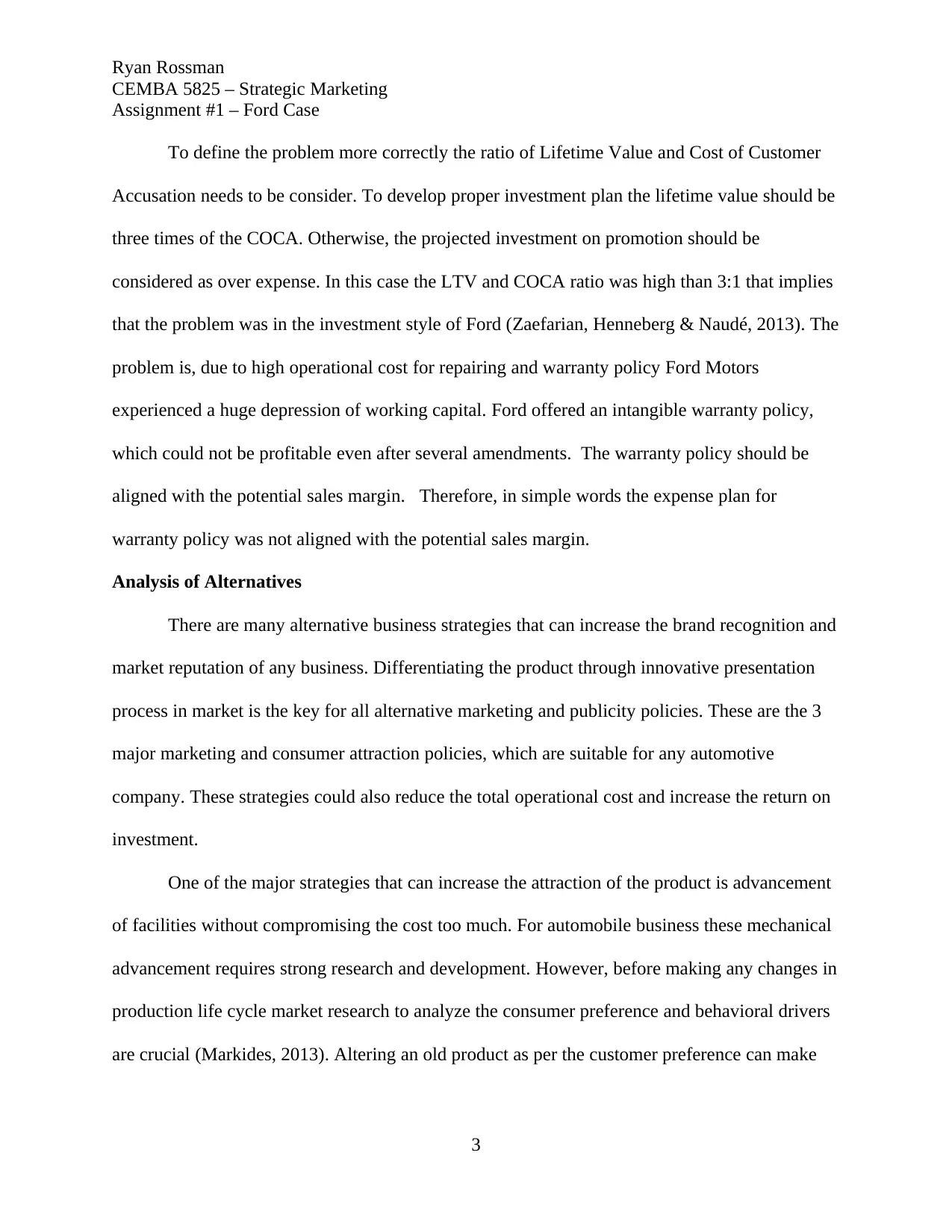
Ryan Rossman
CEMBA 5825 – Strategic Marketing
Assignment #1 – Ford Case
To define the problem more correctly the ratio of Lifetime Value and Cost of Customer
Accusation needs to be consider. To develop proper investment plan the lifetime value should be
three times of the COCA. Otherwise, the projected investment on promotion should be
considered as over expense. In this case the LTV and COCA ratio was high than 3:1 that implies
that the problem was in the investment style of Ford (Zaefarian, Henneberg & Naudé, 2013). The
problem is, due to high operational cost for repairing and warranty policy Ford Motors
experienced a huge depression of working capital. Ford offered an intangible warranty policy,
which could not be profitable even after several amendments. The warranty policy should be
aligned with the potential sales margin. Therefore, in simple words the expense plan for
warranty policy was not aligned with the potential sales margin.
Analysis of Alternatives
There are many alternative business strategies that can increase the brand recognition and
market reputation of any business. Differentiating the product through innovative presentation
process in market is the key for all alternative marketing and publicity policies. These are the 3
major marketing and consumer attraction policies, which are suitable for any automotive
company. These strategies could also reduce the total operational cost and increase the return on
investment.
One of the major strategies that can increase the attraction of the product is advancement
of facilities without compromising the cost too much. For automobile business these mechanical
advancement requires strong research and development. However, before making any changes in
production life cycle market research to analyze the consumer preference and behavioral drivers
are crucial (Markides, 2013). Altering an old product as per the customer preference can make
3
CEMBA 5825 – Strategic Marketing
Assignment #1 – Ford Case
To define the problem more correctly the ratio of Lifetime Value and Cost of Customer
Accusation needs to be consider. To develop proper investment plan the lifetime value should be
three times of the COCA. Otherwise, the projected investment on promotion should be
considered as over expense. In this case the LTV and COCA ratio was high than 3:1 that implies
that the problem was in the investment style of Ford (Zaefarian, Henneberg & Naudé, 2013). The
problem is, due to high operational cost for repairing and warranty policy Ford Motors
experienced a huge depression of working capital. Ford offered an intangible warranty policy,
which could not be profitable even after several amendments. The warranty policy should be
aligned with the potential sales margin. Therefore, in simple words the expense plan for
warranty policy was not aligned with the potential sales margin.
Analysis of Alternatives
There are many alternative business strategies that can increase the brand recognition and
market reputation of any business. Differentiating the product through innovative presentation
process in market is the key for all alternative marketing and publicity policies. These are the 3
major marketing and consumer attraction policies, which are suitable for any automotive
company. These strategies could also reduce the total operational cost and increase the return on
investment.
One of the major strategies that can increase the attraction of the product is advancement
of facilities without compromising the cost too much. For automobile business these mechanical
advancement requires strong research and development. However, before making any changes in
production life cycle market research to analyze the consumer preference and behavioral drivers
are crucial (Markides, 2013). Altering an old product as per the customer preference can make
3
⊘ This is a preview!⊘
Do you want full access?
Subscribe today to unlock all pages.

Trusted by 1+ million students worldwide
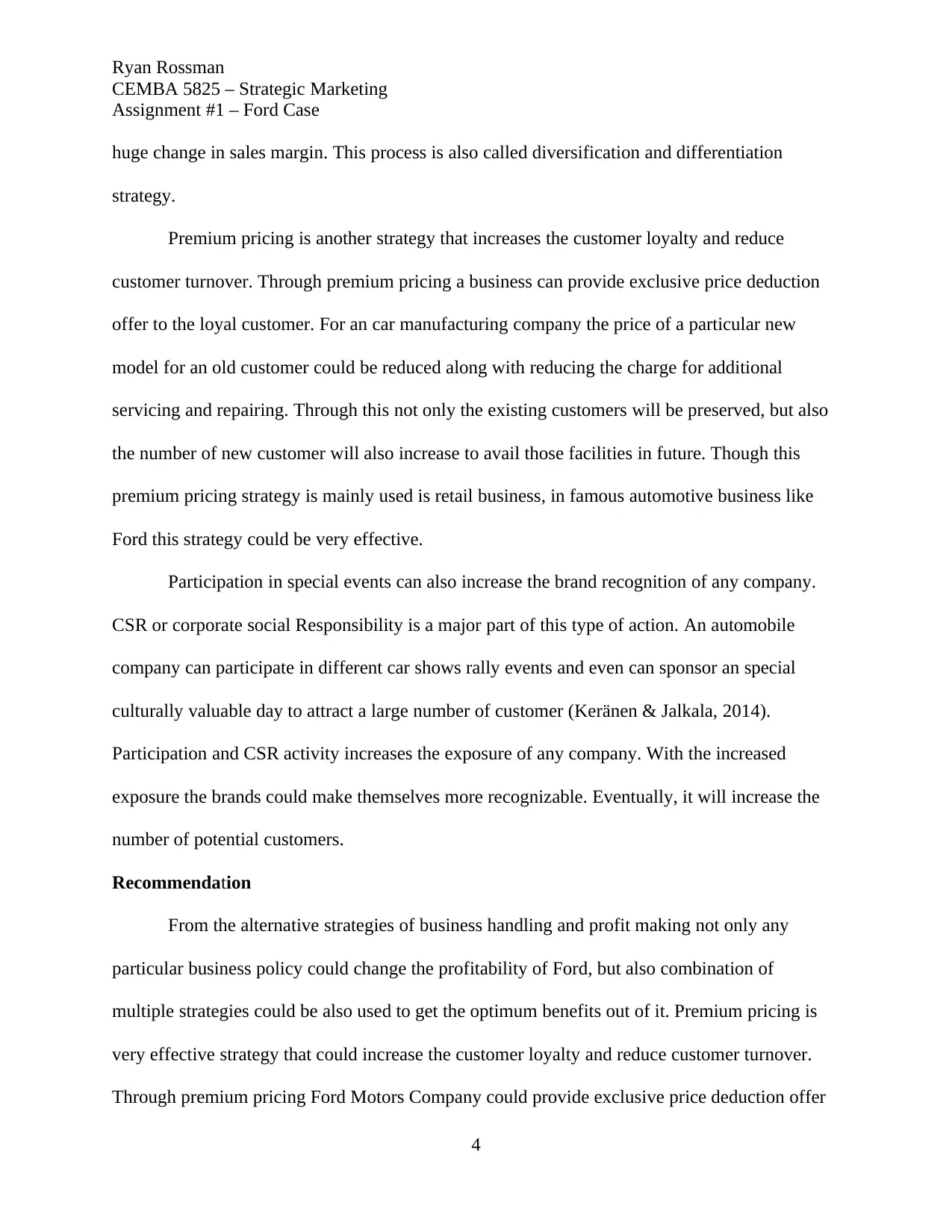
Ryan Rossman
CEMBA 5825 – Strategic Marketing
Assignment #1 – Ford Case
huge change in sales margin. This process is also called diversification and differentiation
strategy.
Premium pricing is another strategy that increases the customer loyalty and reduce
customer turnover. Through premium pricing a business can provide exclusive price deduction
offer to the loyal customer. For an car manufacturing company the price of a particular new
model for an old customer could be reduced along with reducing the charge for additional
servicing and repairing. Through this not only the existing customers will be preserved, but also
the number of new customer will also increase to avail those facilities in future. Though this
premium pricing strategy is mainly used is retail business, in famous automotive business like
Ford this strategy could be very effective.
Participation in special events can also increase the brand recognition of any company.
CSR or corporate social Responsibility is a major part of this type of action. An automobile
company can participate in different car shows rally events and even can sponsor an special
culturally valuable day to attract a large number of customer (Keränen & Jalkala, 2014).
Participation and CSR activity increases the exposure of any company. With the increased
exposure the brands could make themselves more recognizable. Eventually, it will increase the
number of potential customers.
Recommendation
From the alternative strategies of business handling and profit making not only any
particular business policy could change the profitability of Ford, but also combination of
multiple strategies could be also used to get the optimum benefits out of it. Premium pricing is
very effective strategy that could increase the customer loyalty and reduce customer turnover.
Through premium pricing Ford Motors Company could provide exclusive price deduction offer
4
CEMBA 5825 – Strategic Marketing
Assignment #1 – Ford Case
huge change in sales margin. This process is also called diversification and differentiation
strategy.
Premium pricing is another strategy that increases the customer loyalty and reduce
customer turnover. Through premium pricing a business can provide exclusive price deduction
offer to the loyal customer. For an car manufacturing company the price of a particular new
model for an old customer could be reduced along with reducing the charge for additional
servicing and repairing. Through this not only the existing customers will be preserved, but also
the number of new customer will also increase to avail those facilities in future. Though this
premium pricing strategy is mainly used is retail business, in famous automotive business like
Ford this strategy could be very effective.
Participation in special events can also increase the brand recognition of any company.
CSR or corporate social Responsibility is a major part of this type of action. An automobile
company can participate in different car shows rally events and even can sponsor an special
culturally valuable day to attract a large number of customer (Keränen & Jalkala, 2014).
Participation and CSR activity increases the exposure of any company. With the increased
exposure the brands could make themselves more recognizable. Eventually, it will increase the
number of potential customers.
Recommendation
From the alternative strategies of business handling and profit making not only any
particular business policy could change the profitability of Ford, but also combination of
multiple strategies could be also used to get the optimum benefits out of it. Premium pricing is
very effective strategy that could increase the customer loyalty and reduce customer turnover.
Through premium pricing Ford Motors Company could provide exclusive price deduction offer
4
Paraphrase This Document
Need a fresh take? Get an instant paraphrase of this document with our AI Paraphraser
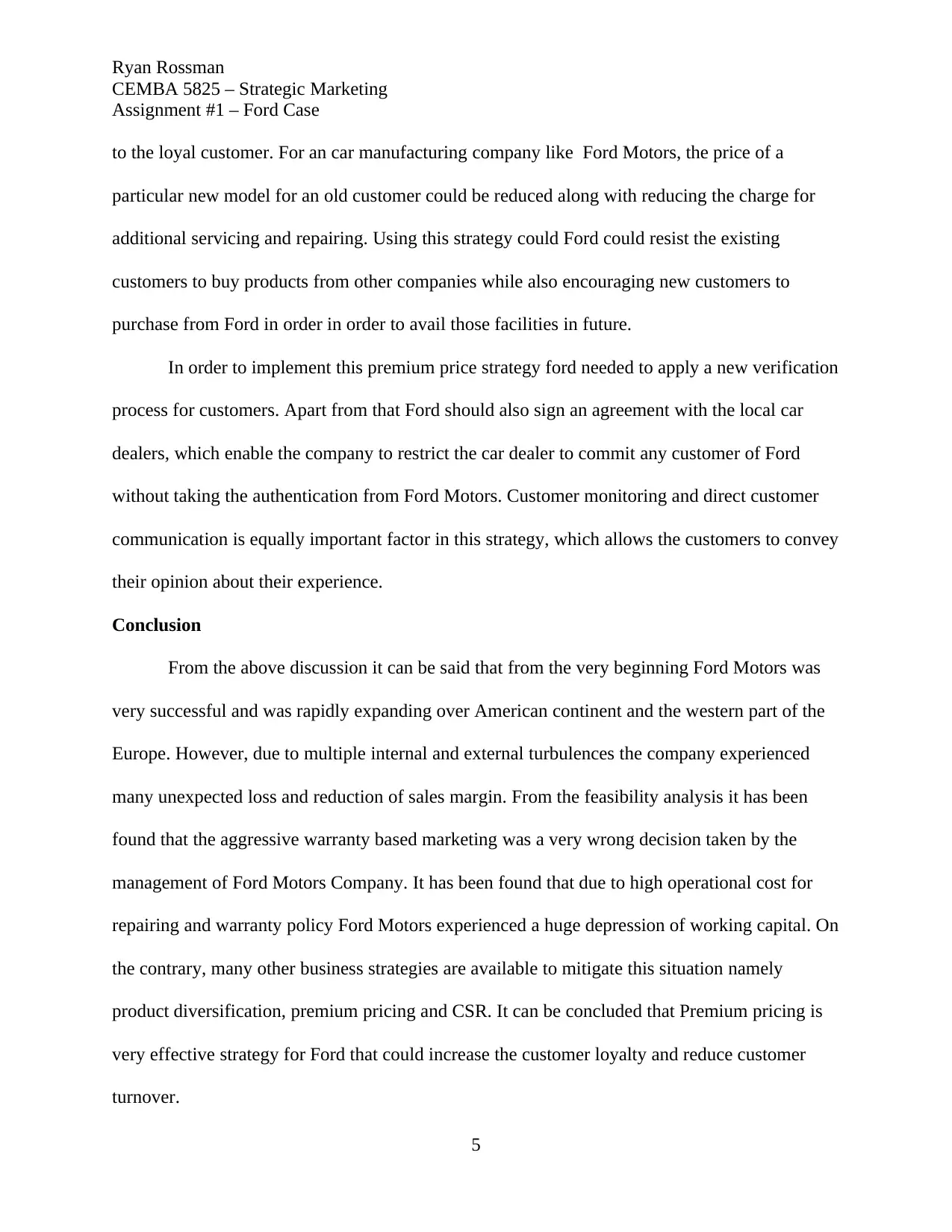
Ryan Rossman
CEMBA 5825 – Strategic Marketing
Assignment #1 – Ford Case
to the loyal customer. For an car manufacturing company like Ford Motors, the price of a
particular new model for an old customer could be reduced along with reducing the charge for
additional servicing and repairing. Using this strategy could Ford could resist the existing
customers to buy products from other companies while also encouraging new customers to
purchase from Ford in order in order to avail those facilities in future.
In order to implement this premium price strategy ford needed to apply a new verification
process for customers. Apart from that Ford should also sign an agreement with the local car
dealers, which enable the company to restrict the car dealer to commit any customer of Ford
without taking the authentication from Ford Motors. Customer monitoring and direct customer
communication is equally important factor in this strategy, which allows the customers to convey
their opinion about their experience.
Conclusion
From the above discussion it can be said that from the very beginning Ford Motors was
very successful and was rapidly expanding over American continent and the western part of the
Europe. However, due to multiple internal and external turbulences the company experienced
many unexpected loss and reduction of sales margin. From the feasibility analysis it has been
found that the aggressive warranty based marketing was a very wrong decision taken by the
management of Ford Motors Company. It has been found that due to high operational cost for
repairing and warranty policy Ford Motors experienced a huge depression of working capital. On
the contrary, many other business strategies are available to mitigate this situation namely
product diversification, premium pricing and CSR. It can be concluded that Premium pricing is
very effective strategy for Ford that could increase the customer loyalty and reduce customer
turnover.
5
CEMBA 5825 – Strategic Marketing
Assignment #1 – Ford Case
to the loyal customer. For an car manufacturing company like Ford Motors, the price of a
particular new model for an old customer could be reduced along with reducing the charge for
additional servicing and repairing. Using this strategy could Ford could resist the existing
customers to buy products from other companies while also encouraging new customers to
purchase from Ford in order in order to avail those facilities in future.
In order to implement this premium price strategy ford needed to apply a new verification
process for customers. Apart from that Ford should also sign an agreement with the local car
dealers, which enable the company to restrict the car dealer to commit any customer of Ford
without taking the authentication from Ford Motors. Customer monitoring and direct customer
communication is equally important factor in this strategy, which allows the customers to convey
their opinion about their experience.
Conclusion
From the above discussion it can be said that from the very beginning Ford Motors was
very successful and was rapidly expanding over American continent and the western part of the
Europe. However, due to multiple internal and external turbulences the company experienced
many unexpected loss and reduction of sales margin. From the feasibility analysis it has been
found that the aggressive warranty based marketing was a very wrong decision taken by the
management of Ford Motors Company. It has been found that due to high operational cost for
repairing and warranty policy Ford Motors experienced a huge depression of working capital. On
the contrary, many other business strategies are available to mitigate this situation namely
product diversification, premium pricing and CSR. It can be concluded that Premium pricing is
very effective strategy for Ford that could increase the customer loyalty and reduce customer
turnover.
5
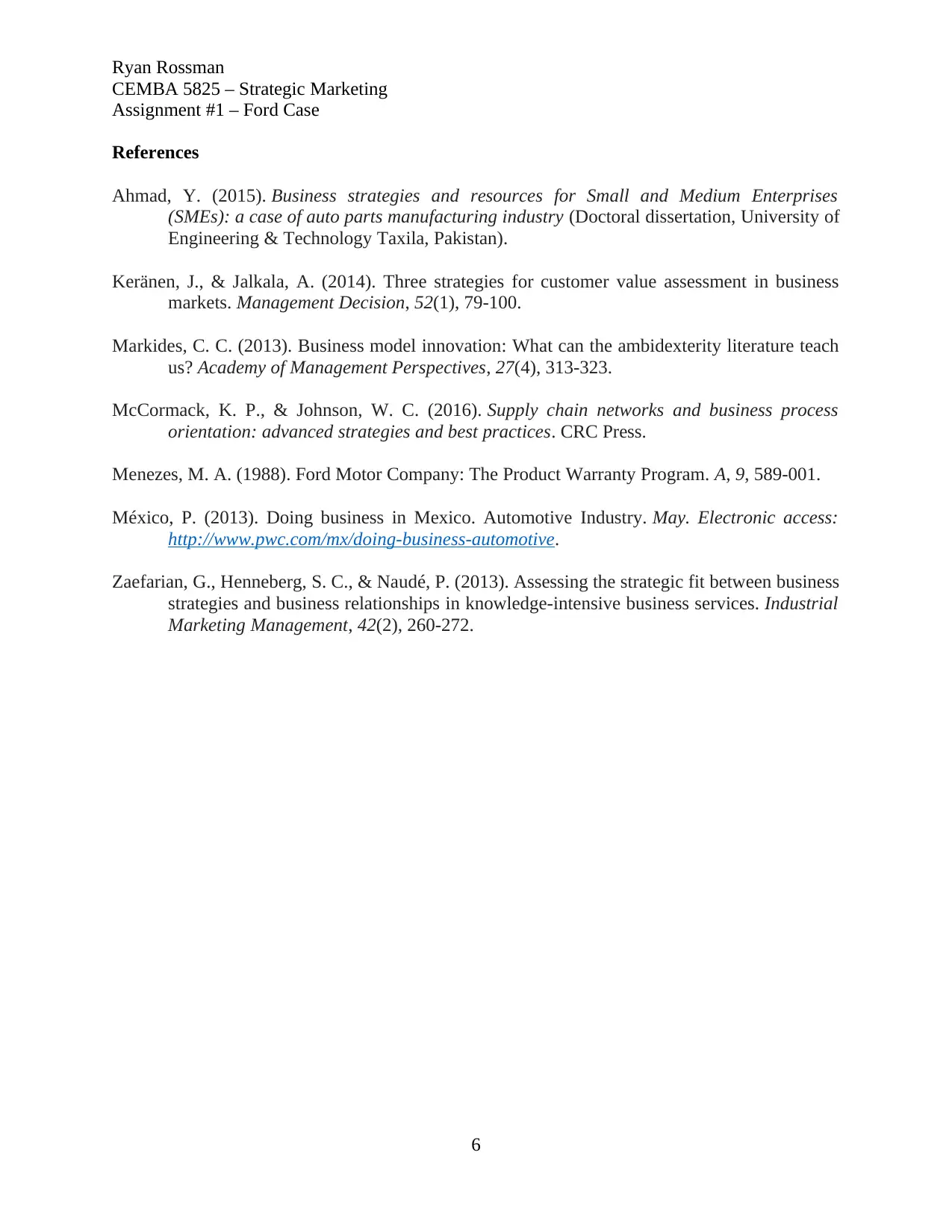
Ryan Rossman
CEMBA 5825 – Strategic Marketing
Assignment #1 – Ford Case
References
Ahmad, Y. (2015). Business strategies and resources for Small and Medium Enterprises
(SMEs): a case of auto parts manufacturing industry (Doctoral dissertation, University of
Engineering & Technology Taxila, Pakistan).
Keränen, J., & Jalkala, A. (2014). Three strategies for customer value assessment in business
markets. Management Decision, 52(1), 79-100.
Markides, C. C. (2013). Business model innovation: What can the ambidexterity literature teach
us? Academy of Management Perspectives, 27(4), 313-323.
McCormack, K. P., & Johnson, W. C. (2016). Supply chain networks and business process
orientation: advanced strategies and best practices. CRC Press.
Menezes, M. A. (1988). Ford Motor Company: The Product Warranty Program. A, 9, 589-001.
México, P. (2013). Doing business in Mexico. Automotive Industry. May. Electronic access:
http://www.pwc.com/mx/doing-business-automotive.
Zaefarian, G., Henneberg, S. C., & Naudé, P. (2013). Assessing the strategic fit between business
strategies and business relationships in knowledge-intensive business services. Industrial
Marketing Management, 42(2), 260-272.
6
CEMBA 5825 – Strategic Marketing
Assignment #1 – Ford Case
References
Ahmad, Y. (2015). Business strategies and resources for Small and Medium Enterprises
(SMEs): a case of auto parts manufacturing industry (Doctoral dissertation, University of
Engineering & Technology Taxila, Pakistan).
Keränen, J., & Jalkala, A. (2014). Three strategies for customer value assessment in business
markets. Management Decision, 52(1), 79-100.
Markides, C. C. (2013). Business model innovation: What can the ambidexterity literature teach
us? Academy of Management Perspectives, 27(4), 313-323.
McCormack, K. P., & Johnson, W. C. (2016). Supply chain networks and business process
orientation: advanced strategies and best practices. CRC Press.
Menezes, M. A. (1988). Ford Motor Company: The Product Warranty Program. A, 9, 589-001.
México, P. (2013). Doing business in Mexico. Automotive Industry. May. Electronic access:
http://www.pwc.com/mx/doing-business-automotive.
Zaefarian, G., Henneberg, S. C., & Naudé, P. (2013). Assessing the strategic fit between business
strategies and business relationships in knowledge-intensive business services. Industrial
Marketing Management, 42(2), 260-272.
6
⊘ This is a preview!⊘
Do you want full access?
Subscribe today to unlock all pages.

Trusted by 1+ million students worldwide
1 out of 6
Related Documents
Your All-in-One AI-Powered Toolkit for Academic Success.
+13062052269
info@desklib.com
Available 24*7 on WhatsApp / Email
![[object Object]](/_next/static/media/star-bottom.7253800d.svg)
Unlock your academic potential
Copyright © 2020–2025 A2Z Services. All Rights Reserved. Developed and managed by ZUCOL.





